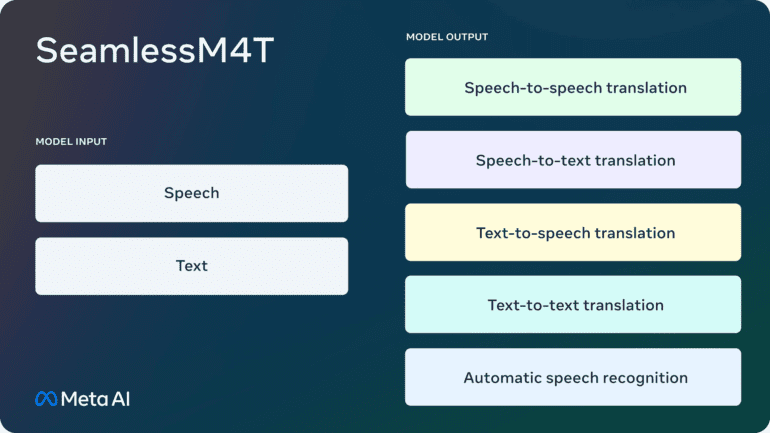TL;DR:
- Meta introduces the Seamless M4T AI model, a breakthrough in language translation.
- This all-in-one model swiftly understands speech and text in 100 languages and provides translations.
- Unique ability to interpret mixed languages mid-sentence enhances user experience.
- SeamlessM4T stands out by eliminating the need for intermediate models, boosting efficiency.
- Meta’s open approach empowers AI researchers with Creative Commons licensed technology.
- The company shares a vast dataset, marking a significant stride in advancing AI translation.
- Seamless M4T builds on Meta’s previous successes in language translation.
- The release follows a trend of AI models excelling in translation, despite concerns about factual accuracy.
Main AI News:
In a significant stride towards breaking down language barriers, Meta has introduced its latest innovation – the Seamless M4T AI model. This cutting-edge technology promises to revolutionize language translation by swiftly and efficiently comprehending both spoken language and written text in an impressive array of 100 languages. This momentous release positions Meta as a frontrunner in the realm of universal communication, showcasing the prowess of AI in bridging linguistic gaps.
In a recent blog post, Meta proudly presents its novel translation system as an unparalleled marvel, marking it as the “first all-in-one multimodal and multilingual AI translation model.” This revolutionary creation encompasses speech recognition and speech-to-text translation capabilities for nearly a hundred diverse languages. Notably, the model demonstrates its versatility by seamlessly interpreting both spoken and written content, rendering translated outputs in 36 spoken languages and 35 written languages. Moreover, Meta’s Seamless M4T boasts an exceptional feature: the ability to decipher language shifts within a single sentence. This facet is particularly invaluable when dealing with individuals who effortlessly interweave multiple languages in their discourse, an occurrence known as codeswitching in linguistic circles.
Meta’s Research Scientist Manager, Paco Guzmán, elucidates the ingenuity behind Seamless M4T, stating, “SeamlessM4T is a unified multilingual model, meaning that it doesn’t rely on intermediate models to produce results. Other cascaded systems for spoken translation often do: speech recognition, text translation, text-to-speech generation. SeamlessM4T does it in a single go.” This streamlined approach not only enhances efficiency but also reduces potential errors, contributing to an elevated standard of translation quality.
In an illuminating demonstration, Guzmán exemplifies the model’s prowess by uttering the sentence, “our goal is to create a more connected world.” The AI rapidly discerns the spoken language as English and promptly translates it into Russian. The translated Russian rendition is then articulated by a synthesized voice, nearly replicating a human intonation.
Diverging from past translation paradigms, SeamlessM4T adopts an integrated single-system methodology, a strategic decision aimed at minimizing errors and delays while augmenting overall translation quality. Drawing a literary analogy, Meta likens this comprehensive approach to the famed Babel fish universal translator from “The Hitchhiker’s Guide to The Galaxy.” However, unlike its fictional counterpart, there is no need to insert this technology into your ear canal.
The democratization of knowledge lies at the heart of Meta’s vision, evident through the release of Seamless M4TT under a Creative Commons license. This move encourages fellow translators and AI researchers to build upon Meta’s breakthrough, fostering collaborative innovation. Further reinforcing this commitment to knowledge sharing, Meta also unveils the metadata of SeamlessAlign, an expansive dataset containing over 270,000 hours of meticulously curated speech and text. This resource stands as a testament to Meta’s dedication to advancing the field of AI-driven translation.
In an era where the reliability of large language models in delivering factual information is debated, language translation emerges as a stronghold for these technologies. Seamless M4T owes its existence to Meta’s previous forays into translation models, including a groundbreaking achievement of translating Hokkien, a predominantly spoken language, into textual form. Notably, Meta’s recent introduction of the Massively Multilingual Speech system further solidifies its capabilities, offering automated speech detection and language identification across an impressive spectrum of over 1,100 languages.
Conclusion:
Meta’s introduction of the Seamless M4T AI model signifies a monumental leap in the language translation landscape. This innovation has the potential to reshape the market by providing an integrated, efficient, and versatile solution that caters to the diverse linguistic needs of a globalized world. The open sharing of technology and data showcases Meta’s commitment to collaborative progress, and while challenges around factual accuracy remain, the trend toward robust AI translation solutions is undeniable.

